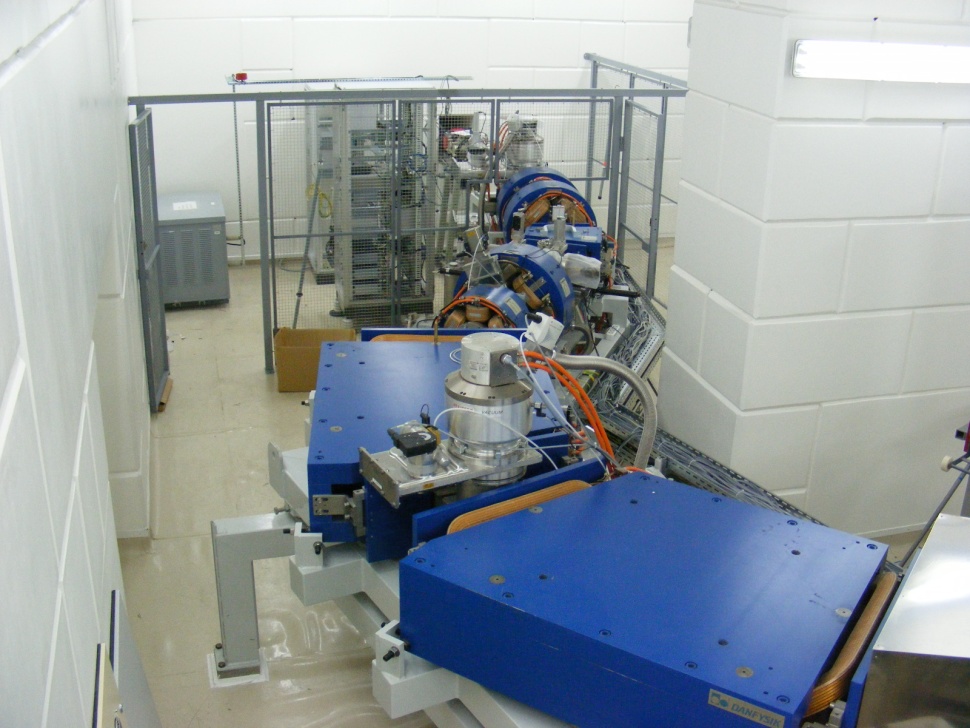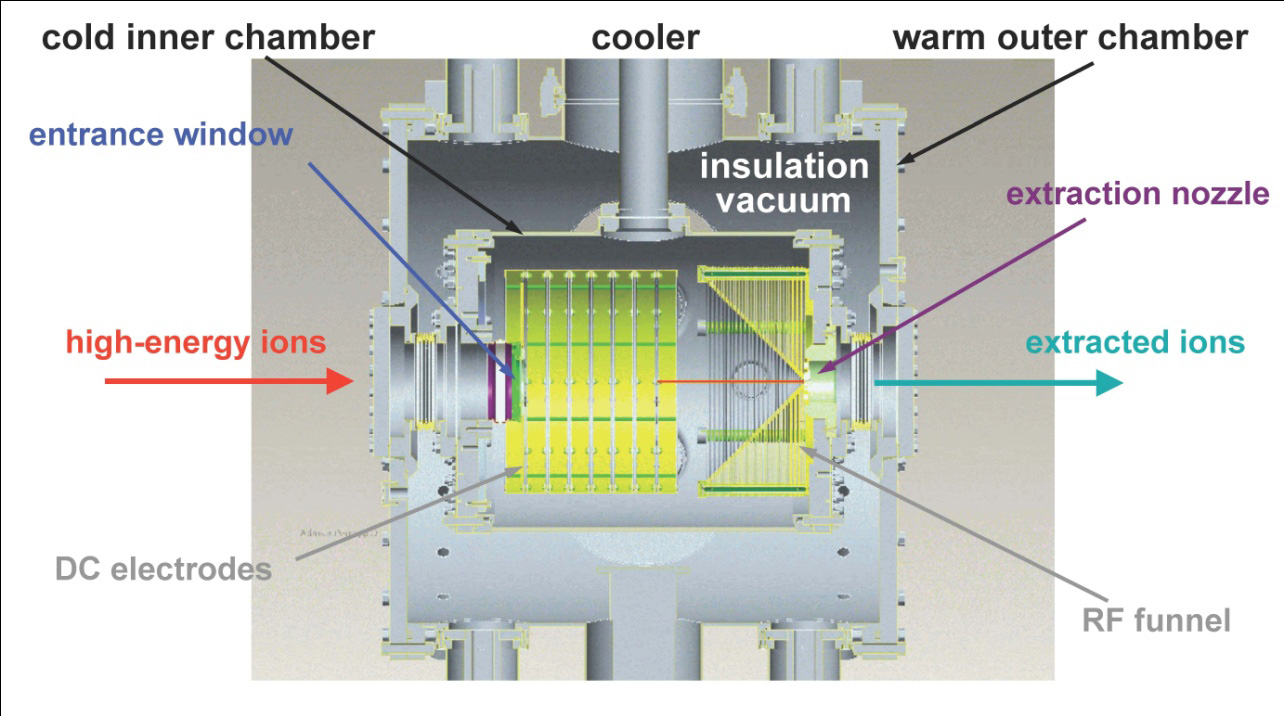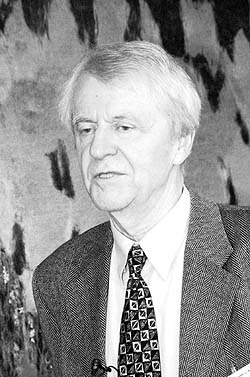Determination of masses of the super heavy elements in the experiments on synthesis of 112 and 114 elements using the reactions 48Ca+238U and 48Ca+242Pu

Subject of thesis (Ph.D., diploma) is devoted to the synthesis and study of properties of nuclei at the stability limits.
(http://flerovlab.jinr.ru/linkc/Virtual_tour/Masha/index.html)
Traditionally, in experiments on synthesis and properties investigation of transuranium and superheavy elements methods are applied, based either on the properties of α-decay radioactive chains ending at well-known nucleus or on radiochemical identification. Thanks to the long lifetimes between 0.1 ms and 30 s) of most superheavy nuclei (Z=112-118), high efficiency kinematic separators which can reliable separate the fusion reaction products from the target-like products and from the primary beam are used. However, these separators do not measure the masses of separated atoms. At the FLNR it was shown that the lifetime of the synthesized isotopes of 112 and 114 elements is higher than 0.5 s and both elements are volatile at room temperature. Thus, experiments on mass measurements of the isotopes of these elements by mass-spectrometer technique with ECR ion source and hot catcher can be carried out. For the first time, such a technique was proposed by the FLNR, JINR and the appropriate mass-spectrometer MASHA (Mass-Analyzer of Supper Heavy Atoms) has been planned and realized. The unique property of this mass-spectrometer is his ability to measure masses of the synthesized super heavy isotopes simultaneously with registration of their α-decay or spontaneous fission. In the first experiment on synthesis we plan to determine the masses of the super heavy elements 112 and 114 using the reactions 48Ca+238Pu and 48Ca+242Pu at beam energy Ebeam = 5-7 MeV/n.
Students will acquire a practical experience with detection technique used in experiments with heavy ion beams: high resolution magnetic mass spectrometer; advanced Data Acquisition System (DAQ) using the high-speed digitizers based on PXI and PXI Express standards; thin window multistrip silicon, MCP (microchannel plates), HPGe and MEDIPIX detectors. The responsibility of students will be to become familiar with data processing and analysis of the experiments, Monte Carlo simulation of focal plane detectors, beam diagnostic (energy measurement by using the silicon detectors, pickup detectors and time of flight technique with MCP detectors), controlling and monitoring the experimental setup with the help of LabVIEW software and programing of DAQ and controlling and monitoring systems in C++, Java and LabVIEW.
Experiments are based on direct cooperation between institutions from Czech Republic, Slovakia, USA and Russia. The tasks for thesis will be performed in the frame of cooperation between IEAP CTU and JINR.
(http://flerovlab.jinr.ru/linkc/Virtual_tour/Masha/index.html)
Traditionally, in experiments on synthesis and properties investigation of transuranium and superheavy elements methods are applied, based either on the properties of α-decay radioactive chains ending at well-known nucleus or on radiochemical identification. Thanks to the long lifetimes between 0.1 ms and 30 s) of most superheavy nuclei (Z=112-118), high efficiency kinematic separators which can reliable separate the fusion reaction products from the target-like products and from the primary beam are used. However, these separators do not measure the masses of separated atoms. At the FLNR it was shown that the lifetime of the synthesized isotopes of 112 and 114 elements is higher than 0.5 s and both elements are volatile at room temperature. Thus, experiments on mass measurements of the isotopes of these elements by mass-spectrometer technique with ECR ion source and hot catcher can be carried out. For the first time, such a technique was proposed by the FLNR, JINR and the appropriate mass-spectrometer MASHA (Mass-Analyzer of Supper Heavy Atoms) has been planned and realized. The unique property of this mass-spectrometer is his ability to measure masses of the synthesized super heavy isotopes simultaneously with registration of their α-decay or spontaneous fission. In the first experiment on synthesis we plan to determine the masses of the super heavy elements 112 and 114 using the reactions 48Ca+238Pu and 48Ca+242Pu at beam energy Ebeam = 5-7 MeV/n.
Students will acquire a practical experience with detection technique used in experiments with heavy ion beams: high resolution magnetic mass spectrometer; advanced Data Acquisition System (DAQ) using the high-speed digitizers based on PXI and PXI Express standards; thin window multistrip silicon, MCP (microchannel plates), HPGe and MEDIPIX detectors. The responsibility of students will be to become familiar with data processing and analysis of the experiments, Monte Carlo simulation of focal plane detectors, beam diagnostic (energy measurement by using the silicon detectors, pickup detectors and time of flight technique with MCP detectors), controlling and monitoring the experimental setup with the help of LabVIEW software and programing of DAQ and controlling and monitoring systems in C++, Java and LabVIEW.
Experiments are based on direct cooperation between institutions from Czech Republic, Slovakia, USA and Russia. The tasks for thesis will be performed in the frame of cooperation between IEAP CTU and JINR.
Double beta decay in experiments NEMO-3 and SuperNEMO

Subject of thesis (diploma, Ph.D.) is connected with the measurement of double beta decay by the detector NEMO-3 and future detector SuperNEMO. NEMO-3 detector was installed in Modane underground laboratory (LSM, France) and contained almost 10 kg of decay isotopes such as 100Mo, 82Se, 116Cd, 130Te, 150Nd, 96Zr and 48Ca. SuperNEMO detector is now under construction (first module) and is devoted to the search of neutrinoless and two-neutrino double beta decay with 100 kg of enriched isotope 82Se.
The responsibility of student will be to become familiar with the detection technique used in both experiments, NEMO-3 experimental data procesing of different modes (neutrinoless, two-neutrino, excited levels) for selected isotope, Monte Carlo simulation for SuperNEMO detector, measurement of energy resolution for scintillating detectors and low background measurements with HPGe detector in LSM.
Both experiments are based on direct cooperation between institutions from France, UK, Czech Republic, Slovakia, USA and Russia. The tasks for thesis will be performed in the frame of cooperation between IEAP CTU and JINR.
The responsibility of student will be to become familiar with the detection technique used in both experiments, NEMO-3 experimental data procesing of different modes (neutrinoless, two-neutrino, excited levels) for selected isotope, Monte Carlo simulation for SuperNEMO detector, measurement of energy resolution for scintillating detectors and low background measurements with HPGe detector in LSM.
Both experiments are based on direct cooperation between institutions from France, UK, Czech Republic, Slovakia, USA and Russia. The tasks for thesis will be performed in the frame of cooperation between IEAP CTU and JINR.
Neutrino physics and astrophysics

Production and spectroscopic investigation of new neutron-rich isotopes near the neutron N=126 and N=152 shell closures using the multinucleon transfer reactions

Subject of thesis (Ph.D., diploma) is devoted to the synthesis and study of properties of nuclei at the stability limits.
The mass-spectrometer MASHA (Mass-Analyzer of Supper Heavy Atoms) was designed for determination of the masses of superheavy elements. The unique property of this mass-spectrometer is his ability to measure masses of the synthesized super heavy isotopes simultaneously with registration of their α-decay or spontaneous fission. The mass-spectrometer is connected to the U-400M cyclotron of the Flerov Laboratory for Nuclear Reactions (FLNR) JINR, Dubna. The position-sensitive quantum counting hybrid pixel detector MEDIPIX provide high spatial resolution and single-quantum detection. This device has an array of 256x256 square pixels of pitch size 55 μm for full sensitive area 14x14 mm2. MASHA+MEDIPIX setup will be used in the investigation of neutron rich nuclei produced in mutinucleon transfer reactions. MASHA can measure any nucleus from helium up to superheavy elements and MEDIPIX detects with high efficiency the beta particles. Nuclei in this region decay mainly by β-. Experiments on the production of new neutron-rich isotopes near the neutron shell closure N=126 and N=152 using the multinucleon transfer reactions: 40Ar,48Ca + 208Pb, and 40Ar,48Ca + 232Th, respectively will be carried out. The beam energy is 5-7 MeV/n.
By measuring the mass, lifetime, energy spectrum of beta particles and by using the position sensitivity of MEDIPIX one can identify these neutron rich nuclei with high accuracy. It is known that the cross sections for these isotopes, using the beam 40Ca, range from 10μb up to 10mb which is enough to obtain sufficient statistics. In the case of 48Ca the yield should be even higher, since 48Ca is more neutron rich isotope. We also plan to expand the investigation of neutron rich nuclei by X and gamma ray spectroscopy using the setups of HPGe detectors with mass-spectrometer MASHA.
Students will acquire a practical experience with detection technique used in experiments with heavy ion beams: high resolution magnetic mass spectrometer; advanced Data Acquisition System (DAQ) using the high-speed digitizers based on PXI and PXI Express standards; thin window multistrip silicon, MCP (microchannel plates), HPGe and MEDIPIX detectors. The responsibility of students will be to become familiar with data processing and analysis of the experiments, Monte Carlo simulation of focal plane detectors, beam diagnostic (energy measurement by using the silicon detectors, pickup detectors and time of flight technique with MCP detectors), controlling and monitoring the experimental setup and programing of DAQ and controlling and monitoring systems in C++, Java and LabVIEW.
Experiments are based on direct cooperation between institutions from Czech Republic, Slovakia, USA and Russia. The tasks for thesis will be performed in the frame of cooperation between IEAP CTU and JINR Dubna.
The mass-spectrometer MASHA (Mass-Analyzer of Supper Heavy Atoms) was designed for determination of the masses of superheavy elements. The unique property of this mass-spectrometer is his ability to measure masses of the synthesized super heavy isotopes simultaneously with registration of their α-decay or spontaneous fission. The mass-spectrometer is connected to the U-400M cyclotron of the Flerov Laboratory for Nuclear Reactions (FLNR) JINR, Dubna. The position-sensitive quantum counting hybrid pixel detector MEDIPIX provide high spatial resolution and single-quantum detection. This device has an array of 256x256 square pixels of pitch size 55 μm for full sensitive area 14x14 mm2. MASHA+MEDIPIX setup will be used in the investigation of neutron rich nuclei produced in mutinucleon transfer reactions. MASHA can measure any nucleus from helium up to superheavy elements and MEDIPIX detects with high efficiency the beta particles. Nuclei in this region decay mainly by β-. Experiments on the production of new neutron-rich isotopes near the neutron shell closure N=126 and N=152 using the multinucleon transfer reactions: 40Ar,48Ca + 208Pb, and 40Ar,48Ca + 232Th, respectively will be carried out. The beam energy is 5-7 MeV/n.
By measuring the mass, lifetime, energy spectrum of beta particles and by using the position sensitivity of MEDIPIX one can identify these neutron rich nuclei with high accuracy. It is known that the cross sections for these isotopes, using the beam 40Ca, range from 10μb up to 10mb which is enough to obtain sufficient statistics. In the case of 48Ca the yield should be even higher, since 48Ca is more neutron rich isotope. We also plan to expand the investigation of neutron rich nuclei by X and gamma ray spectroscopy using the setups of HPGe detectors with mass-spectrometer MASHA.
Students will acquire a practical experience with detection technique used in experiments with heavy ion beams: high resolution magnetic mass spectrometer; advanced Data Acquisition System (DAQ) using the high-speed digitizers based on PXI and PXI Express standards; thin window multistrip silicon, MCP (microchannel plates), HPGe and MEDIPIX detectors. The responsibility of students will be to become familiar with data processing and analysis of the experiments, Monte Carlo simulation of focal plane detectors, beam diagnostic (energy measurement by using the silicon detectors, pickup detectors and time of flight technique with MCP detectors), controlling and monitoring the experimental setup and programing of DAQ and controlling and monitoring systems in C++, Java and LabVIEW.
Experiments are based on direct cooperation between institutions from Czech Republic, Slovakia, USA and Russia. The tasks for thesis will be performed in the frame of cooperation between IEAP CTU and JINR Dubna.
Production of nuclei at the stability limit using a new cryogenic gas-filled catcher

Subject of thesis (Ph.D., diploma) is devoted to the synthesis and study of properties of nuclei at the stability limits.
Two parameters are very important for the mass-spectrometric investigation of isotopes far from stability: the overall extraction efficiency and the delay time. However, an assembly combining a hot catcher and ECR source allows only ionization of the volatile elements with lifetime at least 1-2 s, thus, strongly limiting the experimental possibilities. In the last several years, gas catchers are widely used for production of radioactive beams and turn out to be more perspective. The main advantages of the gas catchers are namely:
• The technique does not suffer from any dependence on chemical and physical properties of the nuclides whose beams are formed in the catcher.
• It provides an essentially faster extraction time (τ ∼ 10 ms) than a hot stopper (τ ∼ 0.3 s).
• There is no need of ionization.
• It is possible to reach a high total efficiency for transformation (up to 40%) of the initial nuclear reaction products to a low energy beam for mass-spectrometric analysis.
Assembly of the gas catcher for the mass separator MASHA is in progress. At the end of the year it is planned to finish the mounting of the setup and in the next year to start the first tests of the gas catcher and use it on the beam. By using the gas catcher it is possible to determine the masses of other superheavy elements (Z=115–118) and also to expand the region of production and spectroscopic investigation of neutron rich nuclei by using the targets 198Pt, 192Os, 186W, 180Hf, 176Yb, 170Er, 164Dy and 160Gd. Another perspective region is around the neutron shell N = 152 by using the reactions 40Ar, 48Ca + 238U, 244Pu and 248Cm. Ebeam = 5-7 MeV/n. Here the neutron rich nuclei undergo not only the alpha and beta but also the spontaneous fission decay.
Students will acquire a practical experience with the detection technique used in experiments with heavy ion beams: high resolution magnetic mass spectrometer; advanced Data Acquisition System (DAQ) using the high-speed digitizers based on PXI and PXI Express standards; thin window multistrip silicon, MCP (microchannel plates), HPGe and MEDIPIX detectors. The responsibility of students will be to become familiar with data processing and analysis of the experiments, Monte Carlo simulation of focal plane detectors, controlling and monitoring the experimental setup with the help of LabVIEW software and programing of DAQ and controlling and monitoring systems in C++, Java and LabVIEW and also development and testing the controlling and monitoring of experimental setup in real time based on CompactRIO acquisition system (FPGA chassis) from National instruments.
Experiments are based on direct cooperation between institutions from the Czech Republic, Slovakia, USA and Russia. The tasks for thesis will be performed in the frame of cooperation between IEAP CTU and JINR.
Two parameters are very important for the mass-spectrometric investigation of isotopes far from stability: the overall extraction efficiency and the delay time. However, an assembly combining a hot catcher and ECR source allows only ionization of the volatile elements with lifetime at least 1-2 s, thus, strongly limiting the experimental possibilities. In the last several years, gas catchers are widely used for production of radioactive beams and turn out to be more perspective. The main advantages of the gas catchers are namely:
• The technique does not suffer from any dependence on chemical and physical properties of the nuclides whose beams are formed in the catcher.
• It provides an essentially faster extraction time (τ ∼ 10 ms) than a hot stopper (τ ∼ 0.3 s).
• There is no need of ionization.
• It is possible to reach a high total efficiency for transformation (up to 40%) of the initial nuclear reaction products to a low energy beam for mass-spectrometric analysis.
Assembly of the gas catcher for the mass separator MASHA is in progress. At the end of the year it is planned to finish the mounting of the setup and in the next year to start the first tests of the gas catcher and use it on the beam. By using the gas catcher it is possible to determine the masses of other superheavy elements (Z=115–118) and also to expand the region of production and spectroscopic investigation of neutron rich nuclei by using the targets 198Pt, 192Os, 186W, 180Hf, 176Yb, 170Er, 164Dy and 160Gd. Another perspective region is around the neutron shell N = 152 by using the reactions 40Ar, 48Ca + 238U, 244Pu and 248Cm. Ebeam = 5-7 MeV/n. Here the neutron rich nuclei undergo not only the alpha and beta but also the spontaneous fission decay.
Students will acquire a practical experience with the detection technique used in experiments with heavy ion beams: high resolution magnetic mass spectrometer; advanced Data Acquisition System (DAQ) using the high-speed digitizers based on PXI and PXI Express standards; thin window multistrip silicon, MCP (microchannel plates), HPGe and MEDIPIX detectors. The responsibility of students will be to become familiar with data processing and analysis of the experiments, Monte Carlo simulation of focal plane detectors, controlling and monitoring the experimental setup with the help of LabVIEW software and programing of DAQ and controlling and monitoring systems in C++, Java and LabVIEW and also development and testing the controlling and monitoring of experimental setup in real time based on CompactRIO acquisition system (FPGA chassis) from National instruments.
Experiments are based on direct cooperation between institutions from the Czech Republic, Slovakia, USA and Russia. The tasks for thesis will be performed in the frame of cooperation between IEAP CTU and JINR.


 MINISTR ŠKOLSTVÍ KE SPOLUPRÁCI ČR S SÚJV
MINISTR ŠKOLSTVÍ KE SPOLUPRÁCI ČR S SÚJV INTEREST JINR, Wave 6
INTEREST JINR, Wave 6 The passing of Ivo Zvára
The passing of Ivo Zvára Call for the projects solved in collaboration with JINR (Projects 3+3)
Call for the projects solved in collaboration with JINR (Projects 3+3)  Call for the Grants of the Plenipotentiary of the Government of the Czech Republic in JINR
Call for the Grants of the Plenipotentiary of the Government of the Czech Republic in JINR Czech Ambassador in Russia visited JINR
Czech Ambassador in Russia visited JINR INTEREST JINR, Wave 5
INTEREST JINR, Wave 5 Russia Visa Centre
Russia Visa Centre Working Stays CR - JINR 2022
Working Stays CR - JINR 2022